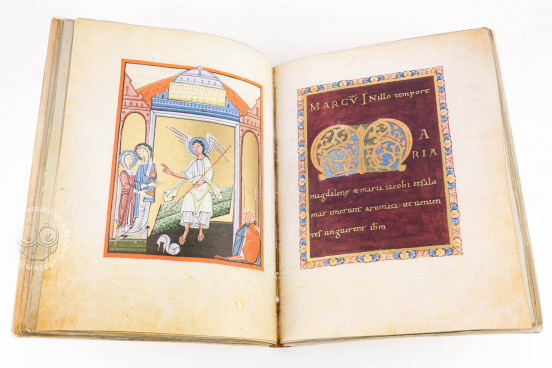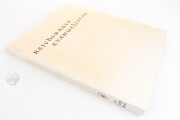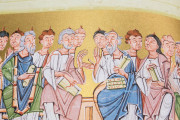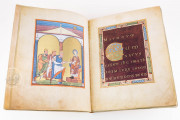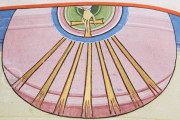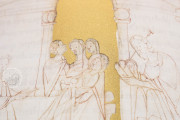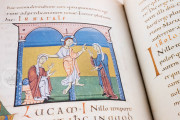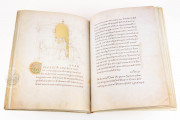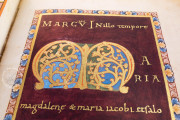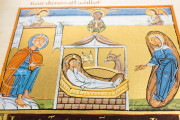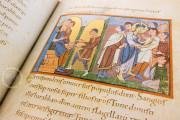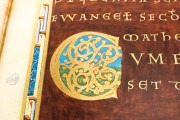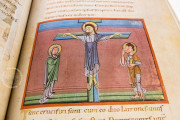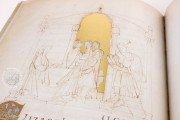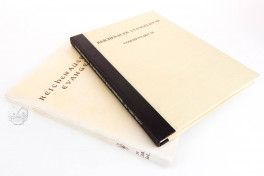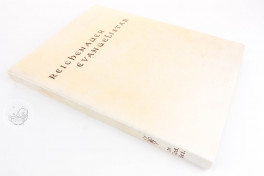The Berlin Gospel Lectionary was produced by the monks of Reichenau sometime around 1056. Its readings from the Gospels for use in the Christian Mass are richly illustrated with heavy use of gold backgrounds, as well as text on purple backgrounds that mark the beginnings of readings for important feast days. Its twenty-two miniatures mostly illustrate scenes from the childhood, mission, and Passion of Christ, as well as the descent of the Holy Spirit on the apostles at Pentecost.
The Berlin Gospel Lectionary was made over 900 years ago in the scriptorium of Reichenau Abbey, then the most important painting school of the West, and is considered the key work for the evaluation of Reichenauian book painting. All 182 pages (91 fols.) of this Gospel Lectionary present the central lessons of the history of Salvation to the reader.
The miniatures, inserted sometimes as full pages, sometimes as strips, are lavishly embellished with gold and still entirely in the tradition of Ottonian art: these illuminations truly enchant the reader with their characteristic delicate charm, so typical of the School of Reichenau.
The fixed order of the pictorial arrangements, a heritage of Ottonian art, unexpectedly combines with an expressive figurative style to overcome the statuary stiffness, long before Romanesque tradition saw the light of day.
Wide swinging gestures lend a strong momentum to the pictures and the enhancement of mimic expression provides the Biblical narrative with emotion and vividness.
The close juxtaposition of different style elements makes of the Gospel Lectionary of Reichenau a typical product of a transition phase that is clearly marked by both traditional elements and a new beginning, thus forming a truly unique synthesis, in an unmatched combination.
A Book of Liturgy
The text of the Gospel Lectionary is written in Carolingian minuscule and ornated with a great wealth of luxurious initials. It starts with one of the four prefaces to the Gospel Book, the third preface of Hieronymus, which is followed by the four prologues introducing the individual Gospels.
The Gospel Pericopes start with the lecture In vigilia nativitate domini and continue with lectures of the ecclesiastical year, from Christmas to Easter and the 26th Sunday after Pentecost, to end with the four Sundays of Advent, the feast days of the saints and a series of votive masses.
A Precious Gift for a Sovereign
The overall character of the manuscript is that of an unfinished work. Some pictures are missing and the miniature of the birth of St. John the Baptist remained unfinished. This is all the more surprising as it was conceived as a gift for a high-ranking personality, judging from the donor's portrait.
The dedication picture shows a crowned sovereign, in his left hand an orb with an eagle. A monk to his left hands him a book, no doubt the Gospel Lectionary of Reichenau. Very little is known about the identity of the sovereign depicted in this dedication picture.
Besides Henry IV, Henry III was mentioned time and again as receiver of the manuscript. Perhaps the sovereign on the one hand and the unfinished state of the codex on the other can be explained by their common historic background: the manuscript might have remained unfinished as the occasion of its donation was no longer valid.
A Unique Manuscript
Although a number of questions are left unanswered, this manuscript is a typical example of a transition phase. Its expressive movements and vivid illustration of the Biblical narrative show a variation of the Ottonian canon of forms. Imperial traditions combine with an effort for purity in both script and liturgy.
We have 1 facsimile edition of the manuscript "Berlin Gospel Lectionary": Das Reichenauer Evangelistar facsimile edition, published by Akademische Druck- u. Verlagsanstalt (ADEVA), 1972
Request Info / Price
